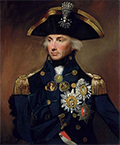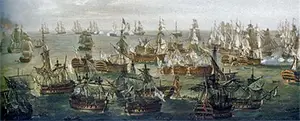The Battle of Trafalgar
The Battle of Trafalgar was a significant victory for the United Kingdom in its early 19-Century war with France. The battle took place off the coast of Spain on Oct. 21, 1805, during the War of the Third Coalition. 
The plan was for the fleets, one French and the other Franco-Spanish, to break through the blockade and cross the Atlantic, to threaten U.K. interests there (much like Bonaparte's plan to divert Britain's attention in 1798 by invading Egypt). Captaining the Franco-Spanish fleet, which was to leave from Toulon, was Admiral Pierre de Villeneuve, who had been second in command in the Battle of the Nile; Honoré Joseph Antoine Ganteaume commanded the French fleet, which was to leave was Brest. Villeneuve's fleet made it to its destination, but the other did not; as a result, the U.K. ships shadowing the Franco-Spanish fleet had less to worry about. Another part of the plan that fell through was a planned invasion of Ireland on the way back: When the rendezvous didn't happen, the Franco-Spanish fleet sailed straight back, breaking through the blockade again in order to put in at port. The naval sorties accomplished a whole lot of nothing for France, and Bonaparte, who had overseen an unsuccessful test of the invasion barges some weeks before, abandoned the plan to invade the U.K. and instead directed the large number of troops that had been dedicated to that purpose to pack up and head east. Those orders came in August. The French and Spanish fleets, meanwhile, were still in the west, still hemmed in by the British blockade. The French and Spanish ships that had made it through the British blockade had to put in at Ferrol, in the south. Their new orders were to sail north, to the northern port of Brest. Villeneuve instead sailed south, to the Spanish harbor of Cádiz, ostensibly to put in for repairs. 
U.K. Vice-Admiral Horatio Nelson (right), who had shadowed Villeneuve's fleet through the Atlantic after first assuming that it was had headed back to Egypt and then been blown off course by a sudden storm, had been on shore leave when he heard that the Franco-Spanish fleet was massing in Cádiz. A large number of ships from the Royal Navy under the command of Vice-Admiral Robert Calder were already en route; these ships had been the ones to go into battle against the Villeneuve's returning ships. Calder's ships reached Cádiz on September 15, and Nelson arrived 13 days later. Enjoying once again the positioning and provisioning capabilities of Gibraltar, Nelson and his fleet gained badly needed supplies. A handful of other ships arrived as well; and by October 15, Nelson's fleet numbered 27 ships of the line and 33 supporting ships. One ships that wasn't there was the Prince of Wales, Calder's flagship; he and the 98-gun ship and crew were sent home so that Calder could face a court-martial for not being aggressive enough against Villeneuve when he returned across the Atlantic. Meanwhile, Villeneuve's fleet had supply problems as well, having gone all the way across the Atlantic and back, suffering damage in battle with Calder's fleet and then lacking money to buy fresh supplies because of the extensive costs associated with the aborted U.K. invasion attempt. Nonetheless, Villeneuve had 33 ships of the line, including one that had 130 guns, and 40 supporting ships. In preparation for the battle, Nelson ordered the sailors to paint a yellow-and-black pattern on their ships, so they could easily tell friend from foe in the heat of battle. For a battle plan, Nelson abandoned the traditional naval line of attack and directed his ships to divide the enemy force into three, attacking head-on at a very fast speed. This unorthodox approach allowed the U.K. ships to minimize the time that the Franco-Spanish ships would have to fire on their attackers. Nelson knew that his forces were experienced and well trained and that the reverse was true for the Franco-Spanish forces. Still, Villeneuve's ships had more men at his disposal–25,000 to 17,000–and plenty of firepower. The encounter had occurred because Villeneuve had sailed from Cádiz in the direction of Gibraltar. The two fleets engaged in battle about 21 miles to the northwest of Cape Trafalgar. 
As planned, the U.K. ships formed two columns and struck at the heart of the enemy ships. Nelson observed the scene and issued orders from his flagship, Victory, while Villeneuve, from his flagship, Bucentaure did the same. The fighting was fierce and went on for five hours. Victory was so successful at engaging the French and Spanish ships that it got close enough to the French ships Redoutable to be boarded. It was then that a French sniper felled Nelson. Another of Nelson's ships, Temeraire, entered the fray and forced Redoutable to retreat and, not long afterward, surrender. Nelson's fleet sunk or captured 22 of Villeneuve's ships (including Bucentaure) and lost none itself. Casualties on Nelson's side numbered 1,500; the 458 dead included Nelson himself, who died not long before the battle ended. French and Spanish losses were much higher: 4,700 dead, 2,500 injured, and several thousand captured. In practical terms, the U.K. blockade of France and Spain continued. The naval strength of those two nations was not again able to sustain any kind of large-scale battle against the U.K. or any other naval power. The very large French army, meanwhile, was engaged in battles on the Continent. The U.K. victory at Trafalgar was one of a number of factors that precipitated Bonaparte's creation of the Continental System as well.
|
|
Social Studies for Kids
copyright 2002–2025
David White




